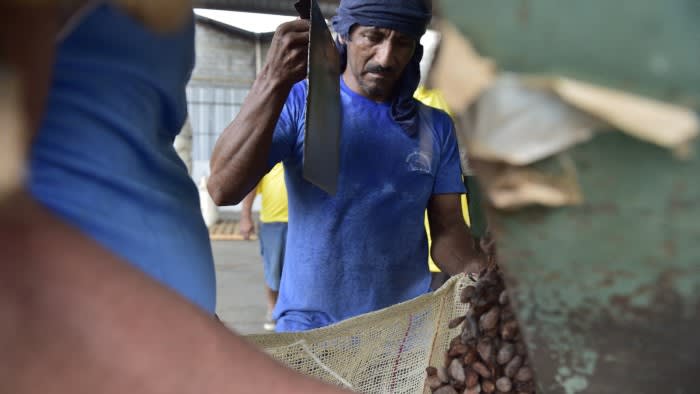
Farmers in Latin America are rushing to plant cocoa as the price of chocolate’s main ingredient soars amid a global shortage of supplies.
Industry figures said farmers in their source markets of Ecuador, Brazil, Peru and Colombia were scrambling to acquire seedlings and adding to the land area devoted to the crop.
Ecuador’s total planted area for cocoa is expected to surpass 600,000 hectares this year, up from 500,000 last year, said the country’s cocoa exporters’ association. While data on new planting is not yet available for many other countries in the region, buyers are seeing an increase.
“It’s not just Ecuador. We’ve seen significant growth in Peru, we’ve seen it in Colombia, Brazil,” said Paul Hutchinson, chief strategic trading officer at Olam Food Ingredients, one of the world’s biggest soft commodity suppliers. “Everybody wants to get involved with growing cocoa.”
New York cocoa futures blasted through previous highs to hit a record $12,191 last week, up from less than $3,000 a tonne a year ago.
If you are a farmer and you see these prices “what are you going to do?” asked Nicko Debenham, former head of sustainability at Barry Callebaut, the world’s largest chocolate maker. “What are you going to plant in the ground? You’re not going to plant yams for Christ’s sake. You’re going to bloody well plant cocoa.”
The cocoa price spike has occurred as crop disease and poor weather slashed yields in west Africa, causing output to plummet as demand for chocolate grows in emerging markets and consumers in rich countries buy more premium products.
Chocolate makers are passing on surging costs for cocoa on to consumers by raising prices, shrinking bar sizes or tinkering with recipes.

Ghana and Ivory Coast, the two biggest producers, supply two-thirds of the world’s beans, but in both countries the government sets the price paid to farmers to protect them from market volatility. This means growers do not directly benefit from ballooning futures prices, reducing their incentive to invest in their plantations in order to boost yields.
Producers in free markets in Latin America, meanwhile, are cashing in.
Edgar Zambrano, who grows cocoa on a one-hectare plot in Ecuador’s coastal province of Manabí to support his chocolate business, said that local farmers were encouraged to produce more.
“More than 80 per cent of the price of [the crop] stays with the producer, and that is important as it means that the majority of the boom reaches the producer directly,” said Zambrano, who is also on the board of a local producers’ association.
Some were ditching other crops, such as bananas and palm oil, in order to plant cocoa, said Hutchinson.
“What we’ve seen in places like Ecuador, which is the fastest growing origin out there, is unprecedented demand for seedlings in order to take advantage of this rise in cocoa prices. Nurseries being built at an elevated speed,” he said.
Cash-strapped Ghanaian and Ivorian smallholders used little fertiliser or pesticides and had ageing trees, which were less productive and more vulnerable to disease and adverse weather, while in Latin America cocoa farming was an industrial operation, Hutchinson said.
Large-scale plantations, with advanced irrigation and ample pesticides, used disease-resistant hybrid seeds. As a result “the yields are on a completely different level”, he added.
One risk is Ecuador’s drug-fuelled crime wave. The government is engaged in a war against organised crime groups, but criminal activity does target cocoa production in the Andean nation.
“We suffer a lot from theft of cocoa on the farm,” Zambrano said. “But also when the farmer harvests and takes his [crop] to sell, he even suffers theft not only of the grain, but of the vehicles too.”
Still, Ecuador could soon outpace Ghana, according to analysts. Latest forecasts from the ICCO, the International Cocoa Organization, estimate that Ghana will produce about 580,000 and Ecuador 430,000 tonnes in the current 2023-24 season.
Production in Ecuador — which lags behind planting, since plants take three to five years to bear fruit — is predicted to grow 6 per cent this year, said Ecuador’s cocoa exporters’ association.
A lack of investment means disease and bad weather could slash Ghana’s output further, while Ecuadorean farmers are piling their bigger profits into stepping up production, said Jonathan Parkman, co-head of agriculture at commodity brokers Marex.
Fuad Mohammed Abubakar, head of the Ghana Cocoa Marketing Company, said he was not worried. “Farmers in Ecuador are producing near-optimal yield levels,” he said. “West African farmers are producing 40-50 per cent of the optimal level. That tells you that there’s opportunity for growth.”
However, industry insiders said the boom might be shortlived. Debenham noted the time required for plants to bear fruit, adding: “By the time it comes to produce, then everyone’s planted cocoa and suddenly [the price] goes back down.”
“Everyone is buying and stockpiling,” said Luís Simo, a corporate supply chain manager for Peru, Colombia and Ecuador at Confiteca, a confectionery manufacturer. “A lot of people see a bubble that at some point will shrink.”
Additional reporting by Michael Pooler in São Paulo
